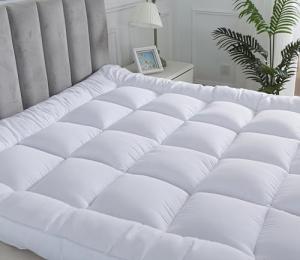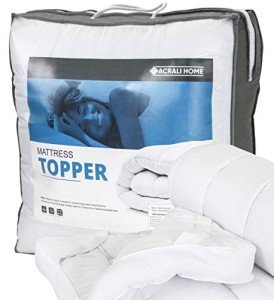In recent years, the demand for comfort-enhancing bedding solutions has surged, leading to the rise in popularity of memory foam mattress toppers. This guide aims to explore the benefits, types, and considerations when selecting a memory foam mattress topper specifically for single beds.
What is a Memory Foam Mattress Topper?
A memory foam mattress topper is a layer of dense foam placed on top of a mattress to improve comfort and support. Made from viscoelastic material, this foam conforms to the body's shape and weight, providing an optimal sleeping environment.
Key Features of Memory Foam Mattress Toppers:
- Conformability: Adapts to the sleeper’s body shape, aligning the spine and reducing pressure points.
- Motion Isolation: Minimizes disturbances from a partner’s movements during the night.
- Temperature Sensitivity: Responds to body heat, providing a warmer sensation when cuddling up.
- Material Durability: High-quality memory foam tends to have a longer lifespan than traditional mattress materials.
Benefits of Using a Memory Foam Mattress Topper
Memory foam mattress toppers provide numerous advantages, particularly for single bed users. These benefits include:
1. Enhanced Comfort
A memory foam topper adds an extra layer of cushioning, making even the firmest mattress feel comfortable and plush.
2. Improved Support
By distributing weight evenly, memory foam toppers help in maintaining proper spinal alignment, which is critical for reducing back pain and discomfort.
3. Temperature Regulation
Some memory foam toppers come with cooling gel-infused technology, which helps in dissipating heat, making them a preferred choice for warm sleepers.
4. Cost-Effective Solution
Instead of investing in a new mattress, a memory foam mattress topper can revitalize an existing bed without breaking the bank.
5. Allergy Resistance
Most memory foam toppers resist dust mites and other allergens, making them suitable for allergy sufferers.
6. Easy Maintenance
Memory foam mattress toppers are generally easy to clean, as many come with removable and washable covers.
Choosing the Right Memory Foam Mattress Topper for Single Beds
When searching for the ideal memory foam mattress topper for a single bed, several factors should be considered:
1. Thickness
Toppers typically range from 2 to 4 inches in thickness. Thicker options provide a more substantial layer of cushioning, while thinner ones offer a slight enhancement to the existing mattress.
2. Density
The density of memory foam often determines its durability and comfort. Here’s a breakdown of different densities:
- Low-density foam (3-4 lbs/ft³): Softer and plush, but less durable.
- Medium-density foam (4-5.5 lbs/ft³): Balances comfort and support.
- High-density foam (5.5 lbs/ft³ and above): Offers firm support and extends the topper’s lifespan, but may feel too firm for some users.
3. Type of Foam
Aside from standard memory foam, various types cater to specific needs:
- Gel-infused memory foam: Offers superior temperature regulation.
- Plant-based memory foam: Eco-friendly alternative with reduced carbon footprint.
- Ventilated memory foam: Features airflow channels to enhance breathability.
4. Cover Material
The cover of the mattress topper can impact its performance. Options include:
- Cotton: Soft and breathable.
- Polyester blends: Often moisture-wicking and durable.
- Bamboo-derived fabric: Hypoallergenic and eco-friendly.
5. Price Range
Memory foam mattress toppers vary in price based on thickness, density, and additional features. Here’s a general price range to help you budget:
| Thickness | Price Range |
|---|---|
| 2 inches | £50 - £100 |
| 3 inches | £100 - £200 |
| 4 inches | £200 - £300+ |
Care and Maintenance of Memory Foam Mattress Toppers
To ensure longevity and maintain hygiene, it’s essential to follow proper care guidelines:
- Rotate Regularly: Flip or rotate the topper every few months to distribute wear evenly.
- Use a Mattress Protector: A waterproof cover prevents spills and stains.
- Spot Clean: In case of spills, dab with a mild detergent and water; avoid saturating the foam.
- Air Out: Occasionally allowing the topper to air out can keep it fresh and odor-free.
Frequently Asked Questions (FAQs)
1. How long do memory foam mattress toppers last?
Most memory foam toppers last between 3 to 5 years, depending on the quality and care given.
2. Can a mattress topper fix a sagging mattress?
Yes, a mattress topper can help alleviate discomfort from a sagging mattress by providing additional support and cushioning.
3. Are memory foam mattress toppers suitable for all sleeping positions?
Yes, memory foam contours to different sleeping positions, making them suitable for back, side, and stomach sleepers alike.
4. Will my body overheat on a memory foam topper?
Some memory foam toppers are designed with cooling features, but traditional versions may retain heat. Opt for gel-infused or ventilated designs to aid breathability.
5. Can I use a memory foam topper on any bed?
Memory foam toppers are versatile and can be used on various bed types, including box springs, slatted bases, and even directly on the floor.
A memory foam mattress topper can be a game-changer for single bed users seeking enhanced comfort and support. By carefully considering the factors outlined in this article, consumers can select the ideal topper that suits their sleep preferences and needs. With the right topper, transforming a standard single bed into a luxurious sleeping sanctuary is not only attainable but affordable.






